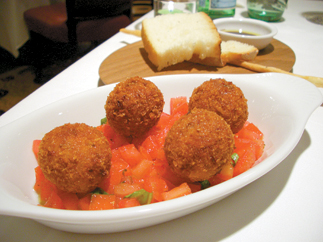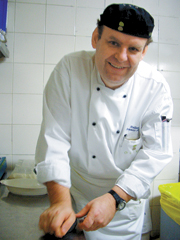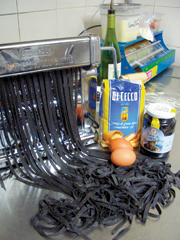Authentic Italian cuisine, minus the airfare

rice balls with mozzarella cheese served with fresh tomatoes. By Ines Cho
Before pan-frying garlic, green celery, white calamari and red tomatoes in an olive-oiled pan, Mr. Sommariva invited me into the kitchen for a look at how he prepares one of his specialities ― black ink tagliatelle with baby calamari, celery and Ligurian basil pesto sauce (22,000 won plus 10 percent VAT and 10 percent service charge at Mr. Sommariva’s restaurant, Olivo, inside Seoul’s JW Marriott Hotel).
To begin, the Italian native went to work on a lump of black dough the size of a grapefruit, pounding it with his thick, gnarled fingers. He popped the dough into the noodle machine and within minutes, he had a large handful of luscious black-ink noodles, or tagliatelle nere. He cooked the noodles for “less than one minute” and threw them into the pan with the vegetables and calamari, stir frying the whole mix. Once off the fire, he wrapped the mixture in a green pesto sauce, and there it was ― a pasta so glorious it deserved an Italian flag.
When chefs cook like prize fighters, lucky diners benefit from their trophies at the table. Mr. Sommariva, the new boss at Seoul’s JW Marriott Hotel kitchen, has practiced upscale Italian cooking in the city’s five-star hotels since he came to Korea in 1999.
A native of Moena, northern Italy, Mr. Sommariva loves to say “We Italians” do this or that and insists on “proper” Italian cooking. He recommended his dishes be accompanied by a glass of Italian white, 2005 Ceretto Arneis Blange DOC Piedmonte. This light and classy white is a house wine sold by the glass (15,000 won). The restaurant stocks an extensive collection from Italy’s wine countries, Piedmonte and Toscana, with the priciest being the bottle of 1999 Agricola Masi “Campolongo di Torbe” Amarone DOC Veneto at 322,000 won.

Black ink tagliatelle with baby calamari, celery and Ligurian basil pesto, served with a glass of house wine and complimentary bread.
Bright red tomatoes served with them tasted like sunny Italy, but the chef said, with a grin, that he used “Italian tricks” to give Korean tomatoes an Italian flavor. (His secret: ripen the tomatoes in the pantry.)
The taste of the deep red spaghetti alla Norma, or spaghetti with eggplant, ricotta cheese, tomato and basil Norma-style (16,000 won) was delicious at first, but I found the commercial noodles spent two minutes too long in the sauce pan. The chef confessed he had talked a little bit while cooking the dish. So this is what happens when chefs are distracted, however briefly, from their battle in the ring, I thought to myself.
Mr. Sommariva was extremely proud of a classic, spaghetti alle vongole (18,000 won), made in the “proper” Italian way.
He said, unlike Koreans who prefer larger shell clams, “We Italians use smaller shells that yield texture and juice.” Mixed with verdant Italian parsley bits, shiny extra-virgin olive oil and shortneck clams opening to reveal creamy, plump bellies, the pasta arrived steaming hot.
I thought the noodles tasted a bit salty and asked him if he thought so too. He sampled and replied sternly, “We Italians think it’s fine.”
Korean chefs who help at Olivo said many local diners have complained, but when the master says its O.K., maybe it is. After all, he didn’t add any salt, except to the water in which he boiled the noodles.
To cool the Mediterranean heat, Sicilian epicures love fancy desserts. I could eat gelatina di arance con gelato al cocomero, or watermelon sorbet served with orange jelly and almond tulip (9,000 won) with a glass of chilled Limoncello, a lemon-based liqueur (11,000 won), everyday.
As I savored the meal, I kept searching for a more accurate description of the taste of the vongole pasta: perhaps “briny” instead of salty.
“Are we supposed to taste the ocean?” I asked.
“Yes,” came the firm reply.
Ah. A lesson learned from a chef ready to tackle Italian cooking in Korea.

In the kitchen, a chef becomes a king. Since Ivan Franco Sommariva took over the JW Marriott hotel kitchen in December, the hotel’s new restaurant, Olive, is kicking with full-on Italian flavors everyday.
The native of Moena, northern Italy, is an advocate of authentic cuisine ― “No fusion, no confusion!” ― and demonstrates what “proper” Italian cooking is all about.

Ingredients for 4-6 servings
100 grams semolina flour
100 grams Italian flour
2 fresh egg yolks
1 tablespoon of white wine
10 grams black ink
dash of salt
*Important tip from the chef: Be sure not to add any water or egg white, which can cause the noodles to stick together. The cut noodles, tagliatelle, look and feel like rubber bands.
1.Mix the flours and salt and shape them into a mound. Create a hollow in the middle and put the egg yolks, black ink and wine in it.
2.Fold the flour into the eggs, black ink and wine until thoroughly mixed.
3.Knead the dough for 15 to 18 minutes.
4.Wrap the dough in a dry cloth and set it aside for 30 minutes at room temperature.
5.Using a rolling pin, repeat flattening the dough until it reaches a uniform thickness of 1.2 millimeters. Sprinkle with semolina flour as needed.
6.Cut the dough into 8 x 10 inch rectangles and slice them into noodles that are 5 millimeters wide.(This can be done using a noodle machine, as shown here.)
7.Divide the noodles into four to six loose coils.
Tagliatelle nero con moscardini fagagiolini alla Ligure
(Black ink tagliatelle with baby calamari, celery and Ligurian basil pesto)
Ingredients for 1 serving
50 grams of cut celery
1/2 clove of minced garlic
100 grams of calamari rings
100 grams of cherry tomatoes
2-3 tablespoons of white wine
salt and pepper
5-6 tablespoons of extra virgin olive oil
2 tablespoons of basil pesto sauce
1 tablespoon of grated Parmesan cheese
1.Boil 1 liter of water for 100 grams of noodles. Add 25 grams of salt.
2.Heat the frying pan on the fire.
3.Add extra virgin olive oil. Add celery and garlic.
4.Add calamari rings and a splash of white wine and cook.
5.Add 3 tablespoons of water (from the pasta pot) or fish stock.
6.Add sliced tomato and cook.
7.Using a strainer, cook the fresh pasta for less than one minute.
8.Add the cooked noodles directly into the frying pan and stir. Add a splash of olive oil, and a dash each of salt and pepper.
9.Cook for one minute and move the noodles to a mixing bowl.
10.Add the basil pesto sauce and Parmesan cheese and mix thoroughly.
11.Serve immediately.
Olivo
English: spoken, on the menu.
Tel: (02) 6282-6765
Hours: Open daily; noon to 2:30 p.m. for lunch; 6 to 10 p.m. for dinner.
Location: Inside the JW Marriott Hotel in Seocho-dong
Parking: Available
Dress code: Business or smart casual
By Ines cho Staff Writer [inescho@joongang.co.kr]










with the Korea JoongAng Daily
To write comments, please log in to one of the accounts.
Standards Board Policy (0/250자)